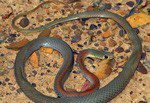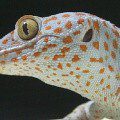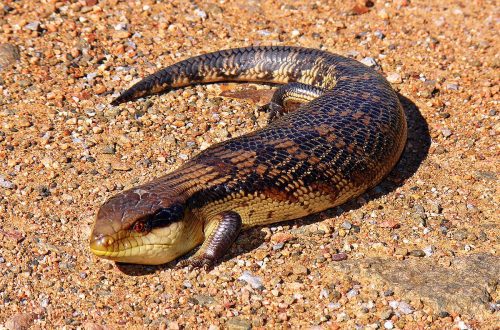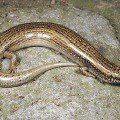
Brown sand snake
The BROWN SAND SNAKE (Demansia psammophis) is noticeably smaller than the reticulated snake, no more than 1,5 m long. This snake is painted grayish-brown from above and yellow from below. It inhabits dry rocky habitats, hunts mainly for lizards and is diurnal. The poison of this snake is not very strong – bitten lizards 15-18 cm long die in about 10 minutes.
Classification
Classification.
Kingdom: Animals
Type. Chords
Subtype: Vertebrates
Class: Reptiles
Order: Scaly
Suborder: Snakes
Family: Already shaped
Genus: Sand snakes
Species: Brown Sand Snake (Demansia psammophis)
Inhabitation
Snakes of this species are common in Africa, South and West Asia. Prefer rocky dry terrain, can be found in sandy deserts. Mostly lead a daily lifestyle.
Description
 It is a slender, agile snake. In length, representatives of this species rarely reach more than 1 meters. The upper part of the body is painted in a grayish-brown color, the lower one is yellow. Sometimes dark stripes run along the body. The head is narrow, pointed, slightly limited from the neck. Frontal shield narrow and long. From above, the head is covered with symmetrical large shields. Her eyes are large, the pupil is rounded. This snake belongs to the group of posteriorly furrowed ones – 5-1 large teeth with grooves, which are separated from smaller teeth by a gap, are located in the back of the upper jaw.
It is a slender, agile snake. In length, representatives of this species rarely reach more than 1 meters. The upper part of the body is painted in a grayish-brown color, the lower one is yellow. Sometimes dark stripes run along the body. The head is narrow, pointed, slightly limited from the neck. Frontal shield narrow and long. From above, the head is covered with symmetrical large shields. Her eyes are large, the pupil is rounded. This snake belongs to the group of posteriorly furrowed ones – 5-1 large teeth with grooves, which are separated from smaller teeth by a gap, are located in the back of the upper jaw.
This snake is an active predator. When moving on the ground, she raises the front of her body about a third above the surface for a better view. Representatives of this species are excellent climbers. Tracking prey, they can climb the branches of low trees or shrubs.
The venom of the brown sand snake is not very strong, it does not pose a danger to humans.
Food
This snake feeds on small vertebrates.
Reproduction
This snake is oviparous. In clutch there are from 3 to 20 eggs.
Content
 Keeping this snake will require a spacious vertical or cubic terrarium with good ventilation and overhead heating. In the daytime, the air temperature should be 30-32 degrees. At night, it will need to be lowered by 5-7 degrees. As a heat source, it is best to use an incandescent mirror lamp. Its spectrum should be close to the sun. It will not be superfluous to put a UV lamp. Washed river sand is suitable for the substrate. Dry snags or branches will be required in sufficient quantities, as the snake will spend most of its time on them. Do not allow high humidity. The drinker may be small. Several individuals can be kept in one terrarium.
Keeping this snake will require a spacious vertical or cubic terrarium with good ventilation and overhead heating. In the daytime, the air temperature should be 30-32 degrees. At night, it will need to be lowered by 5-7 degrees. As a heat source, it is best to use an incandescent mirror lamp. Its spectrum should be close to the sun. It will not be superfluous to put a UV lamp. Washed river sand is suitable for the substrate. Dry snags or branches will be required in sufficient quantities, as the snake will spend most of its time on them. Do not allow high humidity. The drinker may be small. Several individuals can be kept in one terrarium.
These snakes quickly switch to replacement food. In captivity, they can eat mice and other small rodents. Feeding once a week will suffice.
Sources of
http://ours-nature.ru
http://www.ecosystema.ru
http://www.terraria.ru
http://dic.academic.ru





